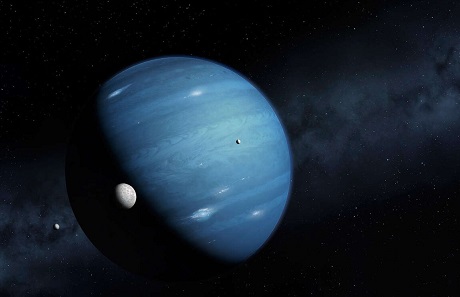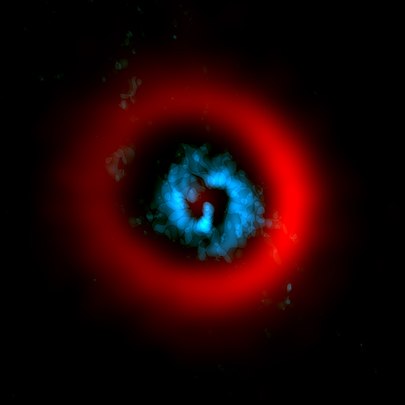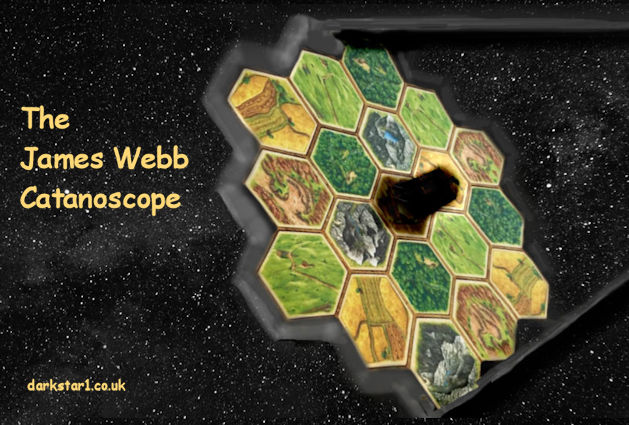Andy Lloyd's Dark Star Blog

Blog 88 (March-April 2022)
New Search Results for Planet Nine
It's been six years since two astrophysics academics at Caltech asserted that Planet X must exist. Re-branding the fabled world as 'Planet Nine', they presented compelling evidence to the world that objects in the outer solar system were being shepherded by a distant, but significant planetary object (1). This theoretical work led to an excited effort to find this undiscovered planet, involving several significant telescope arrays and even a popular citizen science project to help crunch the data (2). In the continuing absence of a direct observation, astrophysicists have passionately argued the merits of the case one way or another (3,4).

Image credit: Mark Garlick/Science Photo Library/via Getty Images
Finding this object is fraught with difficulties. There's no reliable treasure map to work with, and the projected brightness of this object is, well, not very bright at all. Planet X may well evade the most sensitive visible light searches available, so searches using other bands on the electromagnetic spectrum become important. For instance, the infrared space telescope WISE had a good hunt around for brown dwarfs in our neighbourhood, and was able to constrain the size and distance of a potential massive Planet X object considerably (5). Another long-term effort has involved a sky search in the millimetre band, using the Atacama Cosmology Telescope in Chile. This hunt has recently published its findings based upon 7 years of ACT data (6). On the face of it, they aren't particularly encouraging - although the search itself only covered about 10-20% of the possible options for Planet 9:
"The astronomers scanned about 87% of the sky accessible from the southern hemisphere over a six year period, and then processed the millimeter images with a variety of techniques including binning and stacking methods that might uncover faint sources but at the expense of losing positional information. Their search found many tentative candidate sources (about 3500 of them) but none could be confirmed, and there were no statistically significant detections." (7)
It's kind of interesting just how many candidate objects popped out of this data. On top of the 3,500 Planet 9-like candidate objects, their paper indicates a further 35,000 'general category' objects. Given the cautious approach applied by astronomers for what is quite a contentious field of study, that's quite a positive. Other research groups based in Chile have been caught out before (8), so no one is going to stick their neck out now unless they're absolutely certain. So, I wonder what happens with the read-out of those Planet 9-like 3500 candidate objects (6)? Does it get passed around in the astrophysical community for others to investigate? Or does it get filed away quietly?
The team 'manually inspected' the top 100 of these candidates which "led to 3 Planet 9–like and 17 general candidates being cut" - likely transient events possibly connected with flaring of background stars (9). They considered the rest not to be statistically significant enough to merit further inspection. Yet, they inject many caveats in their discussion; for example, indicating that a Planet 9 object nearing aphelion might have fallen outside the threshold for their detection (6). In which case, one of those many statistically insignificant detections might be the one, just at the very far end of the range of their search. If these blips are just lost in the cosmic noise, will we ever know for sure?
Written by Andy Lloyd, 21st March 2022
References:
1) Konstantin Batygin & Michael Brown "Evidence for a Distant Giant Planet in the Solar System" The Astronomical Journal, 151:2, 20 January 2016,
2) Andy Lloyd "Backyard Worlds: Planet 9 citizen science project" 22 February 2019
andylloyd.org/darkstarblog71.htm
3) Michael E. Brown & Konstantin Batygin "Orbital Clustering in the Distant Solar System", The Astronomical Journal, 2019; 157 (2): 62
4) Napier, K. J., et al. “No Evidence for Orbital Clustering in the Extreme Trans-Neptunian Objects” Planetary Science Journal, 2 (2): 59, April 2021
5) NASA "NASA's WISE Survey Finds Thousands of New Stars, But No 'Planet X'" 7 March 2014
nasa.gov/jpl/wise/planet-x-20140307
6) Sigurd Naess et al. "The Atacama Cosmology Telescope: A Search for Planet 9," The Astrophysical Journal, 923, 224, 2021
7) Center for Astrophysics, Harvard "Searching for Planet Nine" 11 March 2021
8) Andy Lloyd "Atacama Astronomers Claim Double Discovery of Planet X" 12 December 2015
andylloyd.org/darkstarblog33.htm
9) S. Naess et al. "The Atacama Cosmology Telescope: Detection of Millimeter-wave Transient Sources" The Astrophysical Journal, 915, 14, 29 June 2021
New Planet Migration Model and Planet Nine
Readers of my 2019 book 'Darker Stars' will be familiar with the currently accepted model of solar system formation, known as the Nice Model. The Nice Model involves migration of the gas and ice giants - Jupiter inwards and Saturn, Uranus and Neptune outwards. In the book, I highlighted some of the unresolved issues this complex theory faces. One of them is what triggered this colossal migration of the giant planets. A new hypothesis (published in Nature this month) has been proposed to address this problem:
"...the giant planets’ instability was probably triggered by the dispersal of the gaseous disk. As the disk evaporated from the inside out, its inner edge swept successively across and dynamically perturbed each planet’s orbit in turn...a few to ten million years after the birth of the Solar System." (1)
Computer simulations suggest this early event might have laid out the solar system's larger planets into their current positions before the terrestrial worlds, including Earth, even formed. There is an additional feature of this early assortment: An additional ice giant beyond Saturn required by the Nice Model.
Image credit: Beibei Liu, Sean Raymond & Seth Jacobson (2)
The instability and the subsequent planetary migration involves the ejection of this third ice giant from the solar system:
"In this simulation, the inner disk edge pushes Saturn toward the ice giants, squishing the planets so close that they go unstable. The instability ejects one ice giant and leaves the planets close to their present-day orbits." (2)
Astrophysicist Sean Raymond, one of the authors of this new paper, has previously considered how the purported Planet Nine might have formed (in fact Sean considered all kinds of weird and wonderful stuff!). He suggests three scenarios - orbital instability, capture from a passing star, or ejection of planet-forming remnants by Jupiter and Saturn.
"Let’s rewind the clock to
when the Solar System’s planets were forming in the
protoplanetary disk. Gas giants Jupiter and Saturn
formed quickly. Ice giants Uranus and Neptune grew
from a population of large ice-rock bodies that were
blocked by Jupiter and Saturn. Uranus and Neptune
each underwent at least one humongous collision with
another large body; we know this because their spin
axes are tilted with respect to their orbital
planets (they have significant obliquities,
especially Uranus).
"The growth of the ice giants is not perfectly
efficient. About half of the icy building blocks
don’t end up in a stable planet but instead get
kicked out, usually by Saturn or Jupiter. Planet
Nine could be a large leftover that was kicked out.
After being kicked onto a wide enough orbit,
external gravitational kicks from the Sun’s birth
cluster could shift Planet Nine onto its current
orbit, like we saw above." (3)
So, such an ejection could have ended up producing a Planet X body - one of about 5 Earth masses according to Raymond's blog. If his new hypothesis is correct, then this mechanism could also account for a Planet X body through the ejection of an ice giant planet during the early dispersal of the gas disk. When I asked him about this on Twitter, Sean said that the presence of an extra ice giant wasn't as necessary in the gas disk dispersal hypothesis as it was in the original Nice model and if it was ejected it would likely end up in interstellar space (4). I gently pressed him just a little further, quoting his 2016 speculation about the origin of Planet Nine. Tantalisingly, he replied with:
"Indeed -- there is more to come on that front in the coming months.... ;) " (4)
Written by Andy Lloyd, 28th April 2022
References:
1) Beibei Liu, Sean Raymond & Seth Jacobson "Early Solar System instability triggered by dispersal of the gaseous disk" Nature, 604: pages 643–646, 27 April 2022
2) Sean Raymond @sraymond_astro 27 April 2022
3) Sean Raymond "Scenario 3. Planet Nine is a leftover from planet formation..." February 2016
planetplanet.net blogpost2016/02/04
4) Sean Raymond @sraymond_astro 28 April 2022
AB Aurigae's Weird Dark Stars
For some time, astronomers have been carefully studying the young star system AB Aurigae which lies in the Taurus Molecular Cloud. The main star is just 5 million years old and is about 2.4 times the mass of our Sun. It's reasonable to expect it to have a larger protoplanetary disk than a star like the Sun. But it's forming massive planets and/or brown dwarfs way beyond what we are accustomed to seeing. AB Aurigae's very extensive dust disk (the red disk in the image below) has a gap in it indicating the presence of a probable (but unconfirmed) brown dwarf about 100 Astronomical Units (AU) out (1). It's possible that the star system has had a close encounter with a dense clump from the surrounding molecular cloud - adding an additional 'second generation' disk (2).

Image Credit: ALMA (ESO/NAOJ/NRAO)/Tang et al.
Astronomers have collected evidence that there's a second massive planet forming at twice Pluto's distance from the Sun, this time within the inner region occupied by two gaseous spiral arms (in blue, above). A clump of observed material around 93AU from the star is thought to be a nascent planet of several Jupiter masses (3). The way it's forming is suggestive of a gravitational collapse of material (similar to star-formation) rather than the classic accretion model of planet formation:
""This new discovery is strong evidence that some gas giant planets can form by the disk instability mechanism," says astrophysicist Alan Boss of the Carnegie Institution of Science, who did not participate in the research, but first proposed disk instability in 1997. "In the end, gravity is all that counts, as the leftovers of the star-formation process will end up being pulled together by gravity to form planets, one way or the other."" (4)
AB Aurigae may have more secrets to give up yet - there are signs of planets forming out as far as a whopping 580AU (3). The generally accepted concept that massive planets can only form at the sorts of distances our solar system gas giants form is being shredded.
Written by Andy Lloyd, 6th April 2022
References:
1) B. Oppenheimer et al. "The Solar-System-Scale Disk around AB Aurigae", The Astrophysical Journal, 679 (2): 1574–1581, June 2008
2) M. Kuffmeier, F. Goicovic & C. Dullemond "Late encounter events as source of disks and spiral structures - Forming second generation disks", Astronomy & Astrophysics, 633: A3, Nov 2019
3) Thayne Currie et al. "Images of embedded Jovian planet formation at a wide separation around AB Aurigae", Nature Astronomy, 2022
4) Michelle Starr "This Giant Exoplanet Is Forming in a Very Strange Way, Astronomers Say" 5 April 2022
Massive Jupiter-sized Brown Dwarf
A 64 Jupiter-mass brown dwarf has recently been discovered transiting its parent red dwarf star. The star system, TOI-2119, is about a billion years old and is located just over 100 light years away. The brown dwarf companion, TOI-2119b, is located in quite a close but eccentric orbit around its parent star.
Image Credit: NASA/Caltech
Because it routine cross in front of its star (as seen from Earth, astronomers have been able to study its size using the Transiting Exoplanet Survey Satellite (TESS) mission. They have determined that this brown dwarf (BD) companion isn't much larger in size than Jupiter:
"TOI-2119b has a radius of about 1.08 Jupiter radii, while its mass is estimated to be 64.4 Jupiter masses. It orbits its host star every 7.2 days, at a distance of some 0.06 AU from it. The orbit of this brown dwarf has an eccentricity at a level of 0.337 and is inclined 88.4 degrees. ...the authors of the paper concluded that TOI-2119b may have formed in an eccentric, close-in orbit, or it may currently be undergoing a quick inward migration from a farther out formation distance that will take billions of years to complete." (1)
Because the star system is over a billion years old,
the brown dwarf has had time to burn off its nuclear
fuel, and so cool down considerably from its early
bright youth. This will have led to
contraction as it did so:
"We generally expect BDs to
contract with age as they cool over time as they
lack a mechanism to initiate any increase in radius
like stars do." (2)
Even so, it's striking how dense this object is. It's not much bigger than Jupiter in size, but 64 times as massive! Although not discussed in the paper (beyond its temperature (1750 Celsius)), I can only assume that this brown dwarf is particularly active - a seething and turbulent world of extreme heat and weather. Given what we know about Jupiter's aurorae and X-ray emissions, one can only imagine what this BD is capable of - despite being a 'failed' star.
Written by Andy Lloyd, 1st March 2022
References:
1) Tomasz Nowakowski "New brown dwarf discovered with TESS" 28 February 2022
2) Theron Carmichael et al. "TOI-2119: A transiting brown dwarf orbiting an active M-dwarf from NASA's TESS mission." submitted to MNRAS 17 Feb 2022
SR72-Darkstar

I remember the rumour about a hypersonic spy plane called 'Aurora' back in the 1980s when I paid a lot more attention to the contemporary UFO literature. It seems, then, that US military engineering firms have been working on hypersonic technologies for some time. Whether any of it has got off the ground yet (literally) is another matter, although the Russians are proudly boasting of their sea-based Zircon hypersonic missiles. In March 2022, Russia said it shot Kh-47M2 Kinzhal hypersonic missiles at a weapons depot in western Ukraine, the first time such weapons have been used in anger (1).
In this age of satellite spy platforms with incredibly high-definition capabilities, the need for hypersonic spy-planes may be be less obvious than it was in the early days of the SR71 'Blackbird'. However, armed hypersonic fighter planes or bombers might be a different matter - they are likely to be better at getting past advanced radar systems and anti-aircraft platforms than aircraft deploying stealth technologies (2).

Image credit: Paramount
Over the last few years, Lockheed Martin has been working on an new blackbird, this time a hypersonic drone bomber named the SR-72. The Darkstar!
"The SR-72 Darkstar has been reported to feature a propulsion system that is centered on a turbine-based combined cycle, which merges a modified production fighter turbine engine with a dual-mode ramjet – also called a scramjet. This enables the aircraft to accelerate from a standing start to Mach 6 – double that of the record-setting SR-71 Blackbird." (2)
The “Son of the Blackbird” may also be making an appearance in the new Top Gun movie (3). Of course, this is a fictional representation of a spy plane which is probably still in its research and/or production phase: A prototype SR72 is being readied for take-off in 2025 (4). Perhaps Area 51 will be its proving ground, who knows?
Written by Andy Lloyd, 28th April 2022
References:
1) Alexander Ward 'Russia launched hypersonic missiles due to a low stockpile, sources say' 22 March 2022
2) Peter Suciu "SR-72 Darkstar: Is The US Military Building A Mach 6 Bomber?" 15 Nov 2021
3) Jeff Spry "Does Lockheed Martin's stealthy SR-72 Darkstar spy plane have a cameo in 'Top Gun: Maverick'?" 28 April 2022
4) Artie Villasanta "U.S. Pushes Hard To Build SR-72 Hypersonic Fighter" 23 Nov 2018
The Catanoscope

I love board-gaming and have spent many happy hours playing 'Catan'. Such a strange thing that the hexes of a Catan board are arranged in the same way as those of the remarkable James Webb Space Telescope. I've had a bit of fun knocking this image up.
Apparently, NASA are considering a new name for the now famous space telescope (1). So why not the Catanoscope?
Got to be better than Scopey McScopeface...
Written by Andy Lloyd, 30th April 2022
References:
1) Adam Mann "New Revelations Raise Pressure on NASA to Rename the James Webb Space Telescope" 4 April 2022
scientificamerican.com article
Planet 9 Trilogy

Here's a new fictional offering about Planet X - with an ancient astronaut theme. The author is French, but the books are also available in English:
"2020, Astrophysicist Anthony Hallbrown is desperate to decipher a signal coming from space with the help of Yoko, a Japanese expert in cryptography. They will discover that the source of the signal is none other than the ninth planet in our solar system, never yet officially observed. But their discovery will awaken the Partisans, a former sect led by Asarus Hicks who claims to be the legitimate servant of space travelers, who, according to the theory of ancient astronauts, had come to Earth to genetically create the human race hundreds of thousands of years before our age."
![]() You can order your copy through Amazon.com here:
You can order your copy through Amazon.com here:
![]() If you live in the UK, you can obtain your copy through Amazon.co.uk here:
If you live in the UK, you can obtain your copy through Amazon.co.uk here:
Book Review: Pagan Dreaming
by Nimue Brown
I've reviewed this book about understanding our dreams - from a Pagan perspective:
"Nimue Brown advocates a general re-wilding of the spiritual path: The book found its passion here, extolling a pagan path through the mysteries and an individual connection between spirit and the numinous. Dreams could be thought of as an ante-chamber to a deeper connection beyond. This mystical experience defies reductive reasoning and definition, and is the zenith of the dream-work discussed within this quiet, thoughtful book."
Book review by Andy Lloyd, 25th April 2022:



